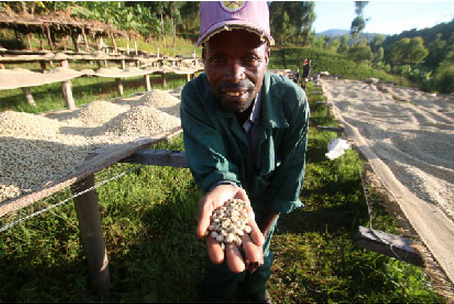Kenyan coffee is highly competitive in the market, and the value chain analysis of coffee
1. Background review
Coffee is one of the most important agricultural products in international commodity trade. Historically, as early as the 1990s, coffee was the second largest internationally traded commodity after oil. However, due to the imbalance between coffee production, production and sales at different stages, the coffee industry has been in crisis more or less over the past decade. As an industry based on natural resources, in the value chain of coffee, the lowest point of economic value appears in the raw material or semi-finished product stage, while the highest point of economic value is in the product-specific and processing stage. After all, coffee is a commodity, so its price will become volatile due to the ups and downs of market conditions, and when the suppliers in the major producing countries do not have enough hard conditions to cope with extreme weather conditions such as torrential rains, it will also have a short-term impact on the coffee industry.
In Kenya, agriculture has made a significant contribution to GDP and local employment, and coffee is Kenya's second largest export after tea. The main coffee bean variety produced in Kenya is Arabica, which is rated as one of the best quality coffee varieties in the world and is mainly used to mix with some lesser coffee varieties to improve the overall quality of coffee. In recent years, however, the market share of Kenyan coffee has shrunk step by step due to strong competitors from other countries and an oversupply of the market.
two。 Value chain structure
1) production
The main coffee variety cultivated in Kenya is Arabica, but in addition, other varieties of coffee beans such as Blue Mountain Coffee (Blue Mountain) and French Missionary species (French Mission) are also grown in some earlier cultivation bases. There are two harvest seasons in a year, the main harvest season is from October to December, and the early harvest season is from May to July.
At this stage, farmers play a major role in the value chain. Their task at this time is to carry out various agricultural activities such as soil preparation, fertilization, spraying, plant maintenance and harvesting. There is a great difference in the employment of agricultural workers between small tenant farmers and large enterprises at this stage. Small sharecroppers can harvest 400 kilograms of fruit per hectare (about 2.1 kilograms per tree), compared with an average of 1.76 tons of coffee beans per hectare (about 8 kilograms per tree). This is mainly due to the fact that there is a certain gap between the basic agricultural tools of sharecroppers and the employment of agricultural workers, the use of modern science and technology is less, and the cost is too high to maximize the use of fertilizer and agricultural spray.
2) processing
Processing is the second stage of the entire coffee value chain, with 90% of Kenyan coffee processed wet and the remaining 10% dry. After the harvest, coffee farmers sell the coffee fruit to partners for further processing, each of which probably has one or two wet processing plants. Among them, 90% of the wet processing is carried out in the central wet mill, and the rest are treated separately, which is very conducive to the maintenance of quality. However, the wet processing machine technology of most of the partners is slightly out of date, so the actual quality of coffee has also been affected a little and declined. Compared with neighboring countries, Kenya's wet mill costs are relatively high, which affects its competitiveness in the international market.
3) auction / marketization
After the processing of coffee beans, the value chain has come to the stage of auction or marketization. The main participants in this stage include bakeries and packaging workshops, warehouse management companies, auctioneers or related business agents. There are two types of coffee marketization mechanisms in Kenya, namely the Central auction Mechanism (Central Auction) and the Direct Marketing system (Direct Sales System). The central auction mechanism is conducted under the auspices of a specific organization, the Nairobi Coffee Exchange (Nairobi Coffee Exchange). At auctions, most marketing agents sell unroasted coffee beans to exporters after cataloging, classifying and setting reserve prices.
4) end market
a. International market (export)
After the stage of auction / marketization, the coffee value chain comes to the end market stage. At this stage, most products are exported in the form of raw coffee beans, only some are sold as processed or roasted coffee beans. As can be seen from the chart below, most of Kenya's coffee beans are sold to Europe, while Germany is the largest importer of coffee beans.
b. Domestic market
There are also many local bakeries in the Kenyan coffee industry, and there are currently about 23 coffee bakeries as the main workshops in Kenya. Major bakeries include Stevkham Enterprise,KPCU Coffee Exporters,Raki Investment,Malaiki Coffee and Tea,C Dorman,Kenya Nut Company,Mwangi Coffee,MA Pandit&Co,Bico,Cejo Investment,Cnetral Impex Enterprise and Nairobi Java House.
Kenya has a limited share of the local coffee market, because there are fewer local coffee drinkers in Kenya, so most of the coffee beans are sold abroad.
5) support the market
Some coffee industry support industries are involved and involved in the production, processing and baking of the entire value chain. The main supporters include water suppliers for agricultural irrigation and wet processing, power supply companies for production, processing and baking, and fertilizer and pesticide plants that provide fertilizer and spray during the production phase. In addition, the equipment supply and maintenance company and the agro-industrial capacity training company also played a certain role in the production process.
The original text is written in English | Wang Xiaozhi
Exclusive compilation of SMASH A CUP | Elvan
A brief introduction to the author
Wang Xiaozhi, graduated from the School of International Relations, Peking University, and majored in International Development practice, School of International Relations and Public Affairs, Columbia University. Long-term attention has been paid to such issues as Chinese investment in Africa, agricultural cooperation between China and Africa, and community agricultural development in Africa. He has been stationed in Kenya in the past year and traveled to Uganda, Tanzania, Mauritius and other countries to participate in and observe the survival and development of local international organizations, Chinese enterprises and civil society.

Important Notice :
前街咖啡 FrontStreet Coffee has moved to new addredd:
FrontStreet Coffee Address: 315,Donghua East Road,GuangZhou
Tel:020 38364473
- Prev

Starbucks ice brew selection stores limited supply of Cold Brew cold iced coffee
On July 29th, Starbucks limited the supply of Cold Brew cold iced coffee in 19 selected stores across the country. This new product is, in more popular terms, iced coffee. In fact, it has been less than four months since it was placed on the Starbucks table in the United States, and it is obvious that the appreciation from coffee gluttons makes the brand can't help bringing it to more customers, such as the fast-growing Chinese market.
- Next

Introduction of 2016 International (WBC) Competition process and registration method
The content of the WBC competition is mainly composed of three parts: Espresso,Cappuccino and Signaturecoffee, namely espresso, cappuccino and creative coffee. In the past, the requirement for cappuccino was quite strict, with single espresso mixed with whisked milk, the thickness of the foam was not less than one centimeter, and the size of the container was limited to 150~180ml. What?
Related
- Is espresso stored overnight in the refrigerator harmful to your body? Is frozen coffee better than freshly ground coffee?
- What parameters and proportions of water temperature should be used to grind and brew fresh coffee beans? Why can't I drink freshly roasted coffee right away?
- Customers have "changed" Manner's new products! Shop assistant: Please don't mess around!
- Remove sockets in customer areas at Starbucks stores?! Netizen: I won't go if I really tear it down
- What is the difference between the taste steps of sun-dried coffee and washed coffee? Why is sun-cured coffee sweeter and washed coffee sour?
- The recipe for salty grapefruit dirty is revealed! Coffee Festival salty grapefruit dirty coffee making materials parameters ratio milk share!
- How about the flavor of Sunlight 74158 at Sidamo Banshaha Mathieu Processing Factory in Ethiopia? 74158 Share the proportion of coffee brewing parameters!
- What effect does Italian American coffee with filter paper have? Will coffee taste better if it is put on filter paper at the bottom of the powder bowl?
- What is the color difference in coffee beans? What are the characteristics of honey processed coffee beans? Why are the anaerobically treated coffee beans uneven in color?
- How does novice Xiaobai quickly get started and make coffee? Newbies learn to make coffee by hand and share the specific steps and process process!

